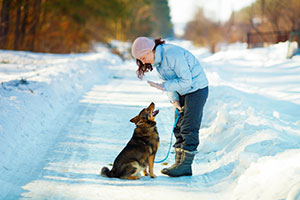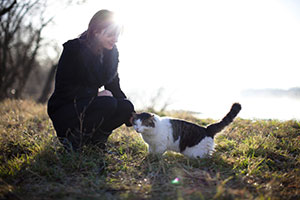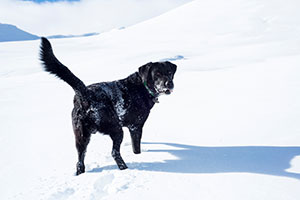What is clicker training?
If you’re on this website, and reading this article, you are probably interested in clicker training—and for good reason. The clicker is a wonderful tool. It lets us communicate more clearly with other species (as well as with our own, in some cases). It helps us focus on the behavior we want to see. It also enables the training of behaviors that would be extremely difficult, or even impossible, to train in any other way.

There’s more to clicker training than just using a clicker, though. While clicking and treating are at the core of what most people think of as clicker training, to me clicker training is something that happens even when there is no clicker in the picture. You are probably thinking, “There are many markers other than clickers that trainers can use, such as whistles,” and that is certainly true, but I’m trying to get at something more basic. Clicker training in its highest form goes way beyond formal training sessions. At its best, clicker training is the gateway to a world in which animals—and their choices—are better respected.
Training with a clicker
For the purposes of this article, I will refer to the use of a positive-reinforcement marker followed by something reinforcing to the animal as “training with a clicker,” whether the trainer is using an actual clicker, a flash of light, a whistle, a tap on the water’s surface, or any other short, sharp, salient stimulus as the marker. In other words, whatever the marker, if you are using one and then following it with positive reinforcement, that falls under “training with a clicker.” I purposely call this “training with a clicker” as opposed to “clicker training,” because I view “clicker training” as involving more than just technique. Back to that in a little bit!
It’s fairly easy to train with a clicker. Watch a few videos, grab some yummy food, and, voilà, you’re off and running. Unfortunately, there are many people out there who view clicker training as being that simple—and that limited. The clicker is a tool they use only to train specific behaviors in formal training situations. Once the training session is over, though, these people go back to interacting with the animal in a very different way. For example, they may jerk the leash when their dog rushes ahead of them, throw a cat off the counter with an angry swipe of their arm, or encourage greater speed in a horse using a crop.
Animals whose handlers behave like this live in a very confusing world. Part of the time they are asked to figure out how to earn a click and treat, which requires creativity and initiative, but the rest of the time, the rules are different. In the formal training context, assuming the trainer is following the basic tenets of training with a clicker, if the animal happens to guess wrong, nothing particularly stressful happens. Outside of that context, though, if the animal misunderstands the signals the environment is sending (“misunderstands” as judged by the human, that is), the situation is completely different. In fact, creativity and initiative when the trainer isn’t holding a clicker may very well result in painful or frightening consequences.
In my mind, the trainer of the confused animal is not a true clicker trainer. He or she is just a trainer who happens to use a clicker sometimes
Clicker training as a lifestyle
At its best, clicker training is a way of life. It’s something that happens between the animal and the handler all the time. As someone who lives with a non-human animal in my home, I spend a great deal of time looking for behavior I like, marking it in one way or another (our domesticated pets tend to be brilliant at reading the natural human behavior that precedes reinforcement), and then reinforcing it.
For example, if I am preparing food, I go out of my way to praise my dog and toss him an occasional treat when he is hanging out just outside the kitchen (as opposed to near the kitchen counters and underfoot). This behavior only took a short while to train back when we first adopted our dog, years ago. Within about a week, I went from tripping over my dog every time I was cooking to having a dog whose preferred spot is just beyond the confines of the kitchen—and I have an English shepherd, so being underfoot is more or less in his DNA.
In a formal clicker training session, the human’s role is to look for correct behavior in the animal, mark it when it happens, and then reinforce it. The handler must have a clear picture of what “correct behavior” is so that s/he can see it and then mark and reinforce it (those who have seen Kathy Sdao speak about SMART training will recognize her terminology here). If the correct behavior doesn’t appear, no click happens. If the correct behavior doesn’t appear for extended periods (in the animal training world that often means anything longer than a few seconds), the handler needs to consider whether the criteria are appropriate, and change them if necessary.
“I know, I know,” you may be saying. “You don’t need to explain to me how to shape behavior successfully.” Those of you who have experience with the clicker are often fantastic shapers, and your use of the clicker in training sessions is a joy to watch. What I want you to think about, though, is what happens when you’re not in the middle of a formal training session with a clicker in your hand. Do you react with anger when your cat jumps on the counter, or do you reinforce her for staying on the kitchen floor? Do you snap at your dog when he climbs on your bed, or do you offer him a cushy bed of his own in a nice sunny spot, and then praise and pet him every time he gets on it?
In a clicker training session, if the animal doesn’t offer the correct behavior, the trainer doesn't yell at, hit, or otherwise punish the animal for failing to get it right. The trainer just waits and gives the animal a second chance (or the trainer adjusts the environment to help the animal get it right). Ideally, errors are not considered the animal’s fault. True clicker trainers understand that it is the trainer’s responsibility to set the animal up for success. After all, we are asking non-human animals to conform to human standards, while we speak a foreign language to them. The least we can do is help them out. And if this is true in formal training sessions, shouldn’t it be true at other times as well?
Clicker training should be about more than just training interesting tricks. It should be about fair treatment and communication. It should also be about allowing the animal to make choices. We may use the click to encourage the choices that we want—a paw movement, for example, if we are training a “wave hello”—but, in the end, the animal gets to choose what to do. The animal also gets to decide whether or not making the choice we like is worth the reinforcer we are offering.
Clicker training and choice
Here’s the bottom line: Done right, clicker training is much more than a formal training technique. It’s a philosophy, a way of viewing the world. It means looking for and reinforcing behavior we like, and ignoring behavior we don’t like unless it’s truly problematic or dangerous (in that last case, it’s a good idea to manage the environment until we can train a different behavior).
Clicker training at its best also means doing this not just in training sessions, and not just when we have a clicker in our hands, but all the time. It’s about reinforcing the animal for what we consider good behavior, whenever it happens. It's also about honoring the animal, respecting natural behavior, and guiding the animal to live more happily within our strange human rule structure.
Ultimately, clicker training, when done right, is about honoring animals’ choices. While we may not always think of it in these terms, we click when we like the choice an animal has made. We often set up the environment to make the “right” choice more likely, but in the end we still have to wait for the animal to make a choice. We’re not out there manipulating the animal using brute force; we’re letting the animal choose what to do. That’s extremely empowering for the animal. In fact, science tells us that choice (a.k.a. control) is one of the most powerful reinforcers out there.
The kind of aversive control I mentioned earlier—sweeping the cat off the counter and so on—reduces an animal’s ability to choose how to behave. What’s worse is that aversive control is likely to increase an animal’s stress, as demonstrated in countless research studies. It’s really not surprising when you think about it. Consider this: How would you feel if a giant hand came out of the sky, picked you up, and then put you down in a different place? To me, that sounds disconcerting, at best. Imagine how terrifying it must be to live in a world where that happens all the time!
Alas, what I just described is the world many small dogs experience. Is it any wonder that smaller dogs are often described as high-strung? People even complain that their dogs run away when they reach down to pick up the dog. To borrow a term from Dr. Susan Friedman, our “cultural fog” is so thick that often people don’t notice the connection between being picked up willy-nilly and running away from reaching humans. It’s so obvious to these people that they have the right to pick up their dog whenever they want, and to move the dog wherever is convenient, that the animal’s opinion simply does not enter into the matter at all—and then they complain that the dog is high-strung, to boot!
Being able to choose what to do, freely and without compulsion, is an incredibly important aspect of life. Because we humans have the power to force behavior, we regularly fail to give animals the opportunity to make even the most basic of choices. For example, even though I try very hard to give my dog many choices, he doesn’t get to choose what he eats. Do I give him nutritious food that I believe is palatable? Yes, but it’s still not his choice. This is just one situation where an animal living with humans doesn’t get to make a choice. How many times a day do you make choices for the animals you interact with?
By being cognizant of when we allow animals to make their own choices, and by paying attention to what is reinforcing those choices, we can understand better why an animal behaves in a particular manner. When we take an animal’s choices away, we lose that opportunity. That means that, strange as it may seem, letting animals make choices actually improves training and leads to better results.
Empowering animals
I believe it’s important to empower animals to make choices. The road to empowerment starts with using choice-rich techniques such as clicker training in sessions where the animal has the choice to participate or not (as well as the choice to earn a click or not, of course).
When I visited Shedd Aquarium a couple of years ago, I was delighted to discover that their animals can leave a training session at any time. If the trainer’s rate of reinforcement isn’t high enough to keep the animal interested, or if the animal is simply overwhelmed or tired, or whatever else, the animal can leave (in many cases, this involves swimming away). What a great gift this is to the trainer! The animal lets you know if a training session is reinforcing by remaining in your presence.
While we’re on this topic, why would you ever want to force an animal to stick around, anyway? If training isn’t a top priority for the animal, the animal isn’t likely to learn much from the session. Consider how much more you learned in classes where you were truly engaged with the teacher or the topic, as opposed to classes where you were forced to sit and listen, but resented the whole experience.
I use the “free to leave” concept in all my clicker training sessions with domesticated animals. I may put up barriers (ex-pens for puppies, for example), but if the animal walks away from me, I honor the animal’s choice and wait for the animal to reengage with me. If the animal keeps leaving the session, I know that something is wrong with the setup, and I adjust the environment accordingly (generally by changing my criteria and raising my rate of reinforcement).

Why not ask your cat if she wants
to be petted, rather than petting her at will?
Letting an animal choose to leave a session may seem like a very small change, but it’s extremely significant. Willing participants are likely to learn more. Having the choice to leave also offers the animal a little more control over his life, and that is extremely beneficial in terms of stress (as illustrated in many scientific studies).
Once you get comfortable with giving animals the choice to participate in formal training, start thinking about other ways you can offer more choice. For example, why not ask your cat if she wants to be petted, rather than just petting her “at will?” Another interesting (and often entertaining) exercise is a taste-test of different food treats with your pet. When my husband and I went through that process with our dog recently we were startled to discover, while comparing two specific food treats, that what we thought was our pet’s favorite treat in fact comes in second to another treat, every time. What might you learn when you let an animal choose?
The great thing about empowering an animal to make choices is that his choices can help us understand what motivates his behavior. For example, if my kitten pounces happily on every leaf he sees blowing on the ground, I know that toys that behave like that leaf are likely to be good reinforcers for him. If, on the other hand, he spends more time stalking larger things that move in a more regular pattern, I would choose different toys for our training sessions. The choices he makes can help inform and improve my training in a million different ways.
Putting choice first
One of the difficulties with adding choice to our animals’ lives is that it often requires us to give up the ability to make the choice we would like best in a certain situation. For example, if I decide I’m going to let a dog choose what pace to walk, that means I need to suit my pace to hers instead of the reverse. This entails a bit of adjustment—both physical and mental.
With some dogs, I’d probably need to walk faster a lot of the time, but I’d also need to be prepared to come to sudden stops when a particularly sniffy spot beckons. With other dogs, I might find the walk only goes a couple of hundred yards, and we dawdle the whole way. This may mean I don’t get my heart rate up for an extended period, but it also means the dog gets to be much more proactively engaged in the environment than when we go on a forced march at my pace. It also means I need to give my dog attention, so that I can observe and promptly respond to changes in the dog’s pace (no cell phones, please!).

An empowered animal is calmer, confident, and
better able to navigate difficult situations.
These adjustments can make the first foray into giving animals more control a bit challenging, so be forgiving of yourself if you find it difficult at the start. Control and choice are just as reinforcing to us as they are to the animals we interact with. Giving up the ability to choose, even only some of the time, can be a bit daunting. For me, though, it’s worth it to give the animals in my life more choices. It can take work, but the benefits are huge. In my experience, an empowered animal is calmer, more confident, more creative, and better able to navigate difficult situations. Doesn’t that sound like a good thing to you?
Editor’s note: To learn more about this topic, plan to attend Irith's Sessions on The Power of Choice at ClickerExpo Dearborn. Two Sessions will be offered:
- Power of Choice Part 1 Locus of Control
- Power of Choice Part 2 Dealing with Problem Behavior



Post new comment